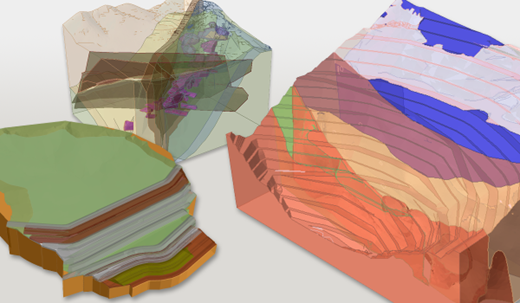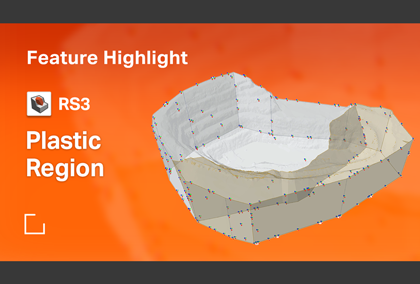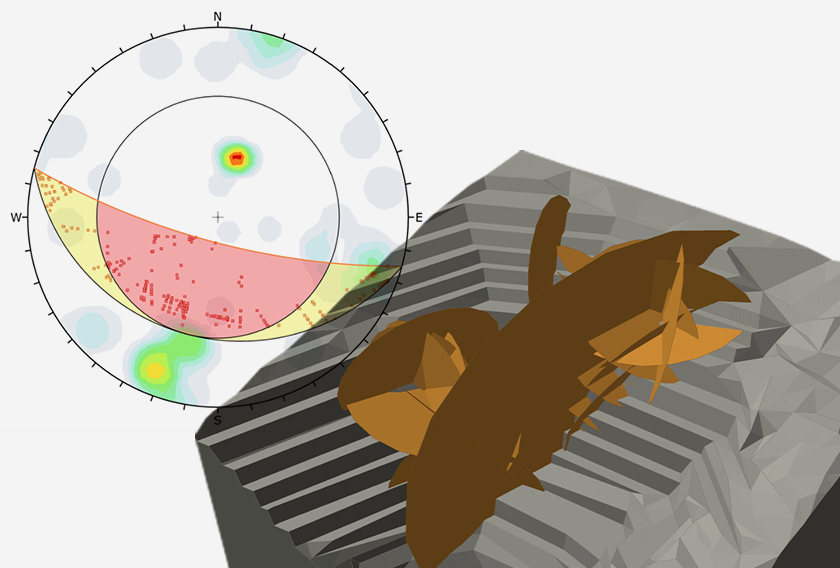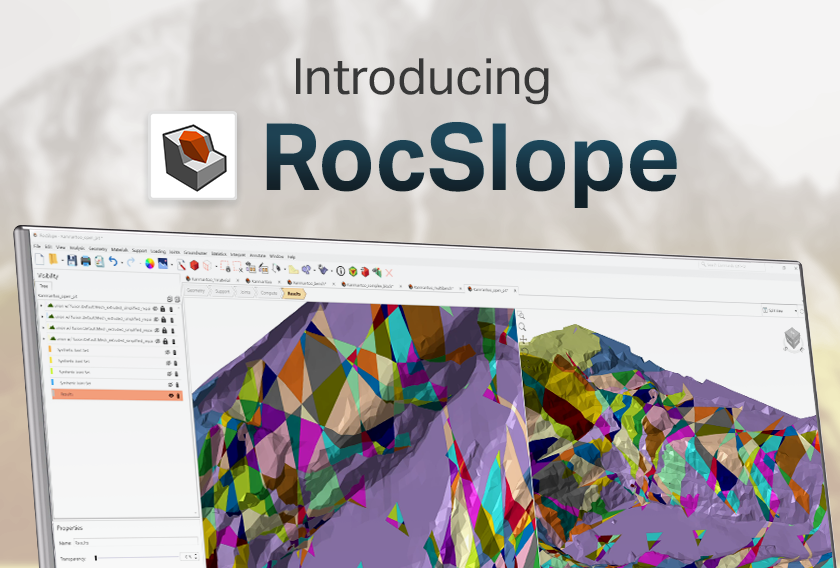Advancing the Frontiers of Blocky Rock Mass Modelling with Discrete Fracture Networks
- Dr. Reginald Hammah, Director of Rocscience in Africa at Rocscience
This article describes the importance of Discrete Fracture Networks (DFNs) in rock mechanics modelling. It outlines capabilities in RS3 (and RocSlope3) to analyze discontinuous (blocky rock mass) responses using DFNs.
Introduction: Rock Masses, Discontinuity Networks and Material Response
Rock masses comprise two key constituents: intact rock material and discontinuities (fractures). Essentially, rock masses are blocky assemblages created by networks of fractures (also known as Discrete Fracture Networks (DFNs) and structural fabric) in intact material.
Discontinuities influence rock mass mechanical and hydrogeological responses to loading and unloading. Compared to intact rock, jointed rock masses have reduced shear and tensile strength and higher deformability and permeability.
Fractures can cause the distribution of stresses and displacements in rock masses to differ significantly from those predicted by classical theories and in a non-linear and anisotropic manner. This heterogeneous nature causes a wide range of rock mass responses (some quite complex) to excavation.
In some cases, discontinuities control rock mass behaviour through sliding along discontinuities, fracture opening and closing, block rotations, and block contacts and connections rearranging. Such mechanical responses are described as discontinuous or blocky rock mass behaviour.
Under other circumstances, the strength and properties of intact materials dictate rock mass behaviour. In these situations, failure is governed by damage to the intact rock, and discontinuities minimally influence deformations.
Whether discontinuous or continuous behaviour reigns is determined by factors, including scale (the geometric extents of excavation problems) and stress levels. It is essential to understand the influence of discontinuities at different scales to ensure the safe and economical design of excavations and geotechnical engineering structures.
Explicitly representing the fractures in a rock mass is a significant challenge. Because it is currently impossible to directly observe the complex 3D layout of fracture networks in rock masses, explicitly representing them in models is not trivial. “Discrete fracture networks” (DFNs) are computational models that attempt to do so by generating fractures randomly distributed in space with specified geometrical properties (orientation, size, position, shape, etc.) and mechanical (and sometimes hydrogeological) attributes.
Incorporating DFNs into geomechanics analysis extends traditional discontinuous approaches such as those implemented in the programs SWedge and UnWedge. These software tools analyze the maximum possible wedges (which can be scaled down to realistic sizes). However, DFNs allow for more realistic modelling by incorporating principal network characteristics such as spacing and persistence.
Although the role of discontinuities has long been recognized in rock mechanics, the ‘best’ approach for capturing their influence continues to be debated.
The remainder of this article will address the different methods available and when appropriate. It will outline the latest DFN capabilities (for generating and incorporating fractures) that we've has implemented in RS3. The article will briefly touch on other software tools, such as RocSlope3, that can integrate structural fabric into analyses.
Approaches to Modelling Discontinuities and their Influence
Three main approaches exist for incorporating the influence of discontinuity networks on rock mass strength, deformation and response to excavation and loading. These are continuum, discontinuum and hybrid methods.
Continuum Approaches
Continuum methods assume that, at the scale of the problem being analyzed, the response of a rock mass is sufficiently captured by an equivalent continuum. This continuous mass completely fills the space it occupies. This medium is not an aggregate of discrete blocks or particles; continuous mathematical functions can describe its physical properties at any point.
We first measure the strength and deformability properties of intact rock samples with laboratory tests to represent a rock mass with an equivalent continuum. We then consider the characteristics of the fractures in the rock mass to downgrade those properties to an equivalent continuum. The Hoek and Brown, an empirical failure criterion, is the most widely used continuum approach in rock mechanics.
Continuum methods are sometimes the only computationally feasible approaches for problems with large geometric extents. When joint spacing is small relative to the sizes of the excavations and geometric dimensions of rock mechanics problems, the computational costs of explicitly representing fractures in models become prohibitive. It is also well-accepted that jointed rock mass behaviours at these scales approach a continuum.
RS3 and RS2, based on the finite element method (FEM), and EX3, a boundary element method (BEM), are all software that can be used for continuum modelling. (RS2 and RS3 are also widely applied to soil and soft rock modelling. As explained later, they can also be applied to discontinuum rock modelling involving small strains.)
Discontinuum Approaches
Discontinuum (or discontinuous) approaches simulate rock masses by explicitly representing the discontinuities in rock masses as discrete features and the intact materials as solids. Essentially, these methods model rock masses as assemblages of discrete blocks. They explicitly capture the geometry, locations, spacing, strength, deformation, and other properties of DFNs. Discontinuous approaches include limit equilibrium methods for analyzing the stability of wedges and blocks and numerical techniques such as the discrete element method (DEM) and discontinuous deformation analysis (DDA). Intriguingly, special joint element formulations allow the FEM to model discontinuous rock mass behaviour.
The main advantage of discontinuum approaches is their ability to model the complex response of joints to stress changes and excavation and the discontinuous behaviours outlined earlier in the article. These methods also more readily capture the influence of reinforcement (support) around openings.
The primary drawback is high computational overhead. As a result, relatively few fractures can be analyzed with these methods, which limits the size of problems they can simulate.
Software for discontinuous analysis also includes the newly released 3D slope stability program, RocSlope3, which evaluates the safety factors of structurally controlled failures of rock slopes based on limit equilibrium analysis. SWedge (for surface wedge stability analysis) and UnWedge (for underground wedge stability analysis) are others.
RS2 and RS3 can simulate discontinuous behaviour until the onset of instability, i.e., before large deformations occur and new block contacts are made.
Hybrid Approaches
As their name suggests, hybrid approaches combine continuum and discontinuum methods in a single model. For example, they can explicitly model the discontinuities in the regions immediately surrounding an excavation and simulate the farther-out areas with a continuum.
RS2 and RS3 can conduct hybrid analysis. The effect of faults on the stability and performance of excavations they intersect is a sample problem that can be handled with hybrid approaches.
Explicitly Incorporating Discontinuities into Analysis – DFN Generation and Import
To explicitly incorporate discontinuities into analysis, the first step is to generate a fracture network in the software or import it. The second step is to perform the requisite limit equilibrium or numerical analysis.
With the recently implemented feature in RS3 for generating DFNs, users can create single or multiple sets of parallel or cross-jointed discontinuity networks. There are plans to expand the types of DFNs that can be generated soon. We also plan to implement the feature in RocSlope3, the recently released 3D software for analyzing wedge stability in blocky rock mass slopes.
Currently, both RS3 and RocSlope3 can import 3D DFN geometries from DXF or other popular file formats such as DWG, Deswick DUF, and Surpac DTM. This feature allows users to include data collected from drone and lidar surveys and processed in software such as Shapemetrix in stability analysis. It also facilitates the use of DFNs created in programs like FracMan.
Concluding Remarks
The response of rock masses to excavation and loading can be complex and challenging due to discontinuities. These behaviours can range from discontinuous to continuous, depending on factors such as stress, and morph with changing problem size or scale. Computer modelling allows engineers to understand or predict these behaviours.
Rock engineering relies on continuum, discontinuum and hybrid methods in their work. We are continuing to help extend the frontiers of blocky rock mass modelling in two ways:
- By developing a DFN generation tool in RS3, the 3D FEM software and
- By creating a 3D limit equilibrium program, RocSlope3, for analyzing the stability of slopes in blocky rock.
We encourage you to explore these new capabilities. They will help you to develop more realistic solutions to your rock engineering problems.



